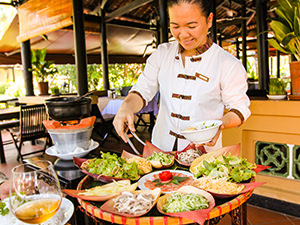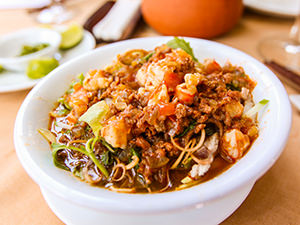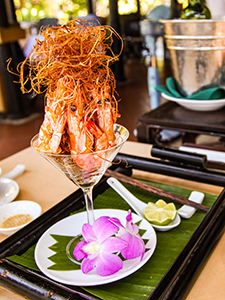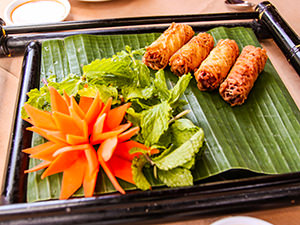There are many reasons which could bring you to Seahorse Resort, a luxurious getaway situated 11 kilometers away from the marine town of Phan Thiet, in Binh Thuan Province, Vietnam.
The long stretch of sandy beach is one of the top world destinations for wind and kite surfing! There are only 45 rainy days in a year here, and the average temperature is 30 degrees Celsius, so sun-chasing might be your next reason to visit.
You might be attracted by the colorful cocktails one can sip at the resort’s large infinity pool, the first of its kind in the whole Mui Ne Riviera.
Or you could just wish to surrender to various therapeutic spa treatments on offer!
Whatever brings you to this part of Vietnam, there is one thing you should not miss: lau tha hot pot, the gastronomic specialty of this region!

Banana flower blooming with food
Every cook has his secrets, so I am sure that Seahorse Resort’s chef Quy Son is keeping a few up his sleeves too. But the basic recipe for lau tha (‘hot pot’ is the literal translation from Vietnamese), mimicked throughout Mui Ne, the kingdom of resorts, is more or less the same.
The main ingredients are served in the petals of a banana flower: sliced steamed pork, julienned cucumber and mango, fried egg, salad, and fresh local fish.
White rice noodle is placed in the bowl, together with the selection of mentioned ingredients. The soup is poured over all of it, and with the addition of rice paper with black sesame, lime juice, and chili sauce (typically a famous local fish sauce with added fried peanuts and chili), the dish is ready for you to enjoy!

The hot pot was originally the food for the poor. Families would mix anything they could find at home, and make the dish that would fill their stomachs.
Reinvented today, this dish is a must-see on all menus of more than a hundred luxurious resorts in Phan Thiet.
Mr. Tran Anh Thi, the general manager of Seahorse Resort, claims it was his idea of redesigning the old dish and the way of serving it, that made it an appealing product easily copied by the competition.
Profit chase with a boomerang effect
The competition is certainly not a small one. For tourists, getting to the ocean from the street became an almost impossible task, as the resorts occupied every inch of the available coastline. Unless you are a guest of the hotel or accept to buy a cocktail at their swimming pool, getting to the beach in this touristically oversaturated zone becomes a hard puzzle. Even when you get to the ocean – you might not find the beach!
If you take from nature, nature takes from you!Tran Anh Thi, Seahorse Resort
“If you take from nature, nature takes from you!”, says Mr. Anh Thi, explaining how many resorts spread too deep towards the ocean, which then claimed some parts of the sand and took it away. The beach might exist today, and disappear tomorrow!
So tourists might be getting a promise of the setting they will not necessarily experience. The irrespective chase for profit shows how boomerang effects can hit our pockets hard.
Mui Ne actually got its name from the fishermen escaping the sea storms (the literal translation of the town’s name means “hiding cape”), but some never learn from the history.

Seahorse Resort – the power in the name
There is an interesting story about how Seahorse Resort also got its name. Even if the owner of the place is female, the name wanted to reflect the male strength!
The traditional drink of seahorse wine is considered to be a powerful sexual tonic, so the resort wanted to take a bit of the symbolic power of the aphrodisiac into its own attraction potential.
Built by Cham architects, it attracted visitors since 2004, at first Vietnamese, but nowadays the guests are mainly Russians, Finns, and Germans. Typically they stay for 12 days, yet one couple recently checked out after the 54-day period!
Temptations of the local cuisine
The food at Seahorse Resort is tempting – whether you just want to enjoy the fruit kebab at the pool, generous breakfast buffet (ranging from Western to Eastern choices, from soups to cakes and tropical fruits), or eat a proper lunch, Seahorse Bistro is ready to serve you well.
Fresh seafood is high on the menu, but one can also find Thai curry, Italian pizza, and even burgers. Personally, I think it would be a pity, if not a sin, to stay in Vietnam and not indulge oneself in Vietnamese cuisine!

My starter was special house spring rolls. Atypically, the wrappers were made of grated dough, which made the fried rolls not only visually appealing but also added to the crispy texture.
Fried prawn served in a glass with lemongrass, combined with the fine white wine of Roc Saint André from Bordeaux, one of the world’s most prolific wine regions, was a mouthwatering introduction to the main course: the great Seahorse fish hot pot.
Lau tha hot pot – tasty, simple, and familiar
When something is proclaimed a signature dish, one can easily make it too complicated. Even if served grandiosely, in front of you, with the soup still boiling on the fire, and the large banana flower design seducing your gaze, the dish reserves the taste of simplicity.
It was never the ostentatious meal at the homes of Vietnamese people – it was always something made of “nothing”. This food was always meant to be shared.
Seahorse hot pot serves three individuals for the price of 530.000 Dongs (22 Euros), which makes it the most expensive dish on their menu, but actually, it is a fulfilling traditional eating experience for a smaller family.
Local ingredients, from vermicelli to fish and fish sauce, combined with local creativity, make it a true Phan Thiet delicacy.
STILL SEARCHING FOR A PLACE TO STAY?
CHECK THESE HOT DEALS IN MUI NE!
DIFFERENT DATES AVAILABLE!
Disclosure: My lunch at the Seahorse Resort was complimentary, but all opinions are my own. Also, this post contains affiliate links, which means if you click on them and make a purchase, Pipeaway might make a small commission, with no additional cost to you. Thank you for supporting our work!


